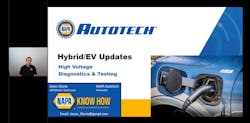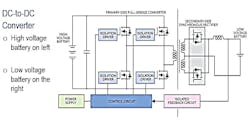Common diagnostics and trends in hybrid and electric vehicles
What we will see in vehicles 14 to 20 years from now will be completely different than what we are seeing now. That is what technicians and shop owners who attended the National Institute for Automotive Service Excellence (ASE) webinar heard last Friday.
“Technicians need to be up to date and onboard to work on electric vehicles (EVs),” said Jason Gloria, ASE Master Technician and NAPA Autotech Instructor. “Electric vehicles are our future, and they’re not going away.”
Gloria hosted ASE’s webinar entitled “NAPA - Hybrid and Electric Vehicle Update” and identified several key topics for techs and shop owners to beware of when working on hybrid and electric vehicles.
Safety first
Although manufacturers have built-in safety features within the high voltage system, technicians still need to take the right steps to remain safe.
First and foremost is using the right tools. Special tools include a CAT III meter and leads as well as high voltage rubber gloves and protective outer leather gloves. It’s important to self-check the rubber gloves before every use. To do so, Gloria recommends filling the gloves with air, then begin to roll up the cuffs to check for leaks.
Secondly, when working on EVs, one must first disable the high voltage system. Every EV will have service disconnects. When a battery service disconnect is pulled out, a sensor will shut down the relays that connect the battery to the vehicle, disconnecting the power from the battery. Since there’s still power in the battery, technicians still need to be careful when working.
It’s only safe to probe the high voltage circuits after the service disconnect is opened, the capacitors have bled down, and DMM confirms 0V in the system, Gloria notes. Once confirmed, it’s then safe to continue working with high voltage gloves. Gloves are always needed when working inside the battery assembly, until voltage levels are safe (12V or less).
The future of EVs
Tesla may not have come out with the first electric vehicle, but they are the ones who “made electric vehicles fun.”
“It’s the whole reason we are where we are,” Gloria noted. “Without Tesla, all these manufacturers wouldn’t be making electric vehicles.”
The original Tesla, the Model S, was the one that made an impact (not the Roadster). The Model S consisted of 16 battery modules with each module holding 444 Panasonic 18650 battery cells, similar to those found in flashlights.
Now, Tesla’s Model Y is fitted with 4680 battery cells. They also created a tabless design to reduce electron flow distance by 500 percent – making it very efficient and eliminates thermal issues.
When it comes to Ford, the manufacturer took the No. 1 selling vehicle in the U.S. – the F-150 truck – and made it an all-electric truck. By going electric, they are taking people to the next step to adopting electric vehicles, Gloria said. It can do everything the gasoline-powered truck can do, plus it can power a house for three days from a full charge.
Most vehicle manufactures have plans in effect to eliminate ICE vehicles as soon as 2035, if not earlier.
Same with state and federal legislation. There are already 12 states that have signed legislation in place to ban the sale of new ICE vehicles by 2035.
Common diagnostics
Gloria shared three common EV diagnostic-related issues that he’s come across.
For one, the warning lights on the dashboard of EVs are different. Gloria pointed out two: a wrench that means non-emissions fault and an orange triangle with an exclamation point, an ISO symbol for “master warning”, that will appear when there’s something going on with the high voltage system.
The high voltage battery is another common issue. Gloria said to check the battery by simply using a scan tool and looking to see which block’s value is under. It’s easy to do, yet many technicians don’t do it at first.
The third most common issue are isolation faults where there’s high voltage leaking somewhere in the system such as the battery, wiring, inverter, etc. Using an insulation tester, technicians can induce high voltage at very low amperage (once the battery is disconnected and verified to be at 0V). This allows hyper accurate readings on all high voltage circuit isolation conditions.
In conclusion, as obvious as it may seem, understanding the system you are working on and diagnosing is key. If you don’t fully comprehend it all, simply ask or use your resources.
“Plot your diagnostic strategy,” Gloria said. “Plan your work, work your plan.”



